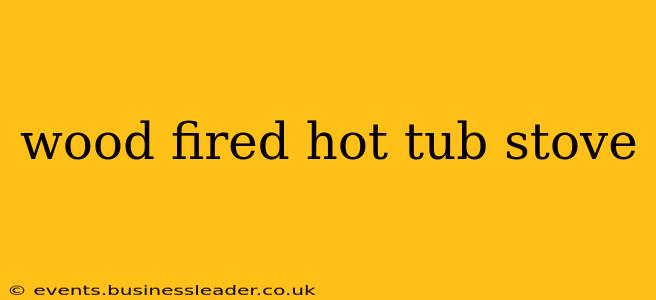For centuries, humans have sought solace and rejuvenation in the warmth of natural hot springs. Now, you can recreate that experience in your backyard with a wood-fired hot tub stove. This guide delves into the world of wood-fired hot tub heating, exploring the benefits, considerations, and everything you need to know before taking the plunge (literally!).
What is a Wood Fired Hot Tub Stove?
A wood-fired hot tub stove is a self-contained heating system designed specifically to warm water in a hot tub or swim spa. Unlike electric or gas heaters, these stoves use the efficient burn of seasoned wood to gently raise the water temperature. They typically consist of a firebox, a heat exchanger (often made of stainless steel), and a chimney for venting smoke. The heat exchanger is submerged in the water, transferring the heat from the fire directly to the tub. This creates a truly unique and environmentally conscious heating method.
How Does a Wood Fired Hot Tub Stove Work?
The process is remarkably simple yet incredibly effective. Wood burns within the firebox, generating heat. This heat is then transferred to the water via the heat exchanger. The hot water circulates naturally through convection, ensuring even heating throughout the tub. The smoke is safely vented through the chimney, keeping your bathing experience clean and smoke-free. The efficiency of the heat transfer is crucial; a well-designed stove will minimize heat loss and maximize the heating power of the wood.
Benefits of Using a Wood Fired Hot Tub Stove
Choosing a wood-fired hot tub stove offers several advantages over traditional heating methods:
- Eco-Friendly: Using sustainably sourced wood is a more environmentally friendly option than relying on electricity or gas.
- Unique Ambiance: The crackling fire and the scent of burning wood create a truly unique and relaxing atmosphere. It's a truly immersive and unforgettable experience.
- Cost-Effective (Long-Term): While the initial investment might be higher, the long-term running costs can be significantly lower than electricity or gas, especially if you have access to readily available firewood.
- Off-Grid Capability: Perfect for remote locations or areas with unreliable electricity supplies.
What are the Different Types of Wood Fired Hot Tub Stoves?
Several designs and features differentiate wood-fired hot tub stoves:
- Internal vs. External Stoves: Internal stoves are placed directly within the hot tub, while external stoves sit beside it, connected via piping. Internal stoves tend to be more efficient but require more careful installation.
- Size and Capacity: Stoves come in various sizes to accommodate different hot tub capacities and heating needs. Consider the size of your tub and the desired heating rate when making your choice.
- Materials: Stainless steel is the most common material due to its durability and resistance to corrosion.
How Much Does a Wood Fired Hot Tub Stove Cost?
The cost varies significantly depending on the size, materials, and features. Expect to pay anywhere from a few hundred dollars for simpler models to several thousand dollars for larger, more sophisticated systems. Remember to factor in the cost of installation and any necessary plumbing or modifications.
What type of wood is best for a wood fired hot tub stove?
Hardwoods like oak, maple, and ash are preferred for their slow, consistent burn and high heat output. Avoid softwoods like pine, as they produce more creosote and can clog your chimney. Always use properly seasoned wood for optimal burn efficiency and minimal smoke.
How long does it take to heat a hot tub with a wood fired stove?
Heating time depends on the stove's size, the tub's size and insulation, and the ambient temperature. Expect to heat a typical hot tub from cold to a comfortable temperature in several hours.
Are wood fired hot tubs safe?
Wood-fired hot tubs are safe when properly installed and maintained. Choose a stove from a reputable manufacturer and ensure it's installed according to the manufacturer's instructions. Regular inspections and cleaning are essential to prevent hazards.
How do I maintain a wood fired hot tub stove?
Regular maintenance is crucial for safety and efficiency. This includes regularly cleaning the firebox and chimney, inspecting the heat exchanger for any damage, and ensuring proper ventilation.
By carefully considering these factors and performing regular maintenance, you can enjoy the unique benefits and relaxing experience of a wood-fired hot tub for years to come. Embrace the warmth, the ambiance, and the eco-conscious approach to outdoor relaxation.
